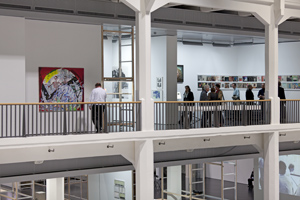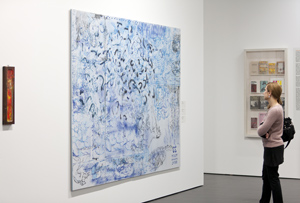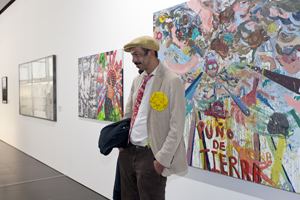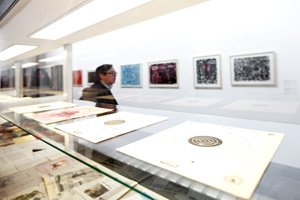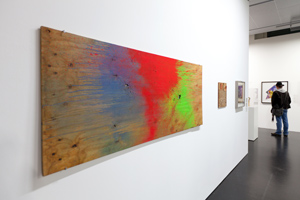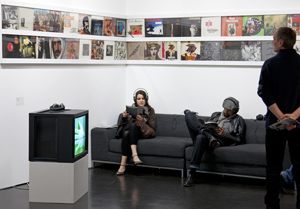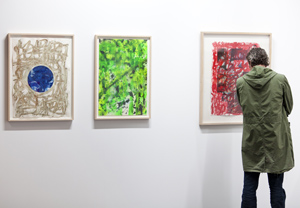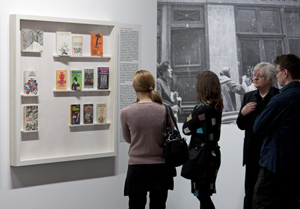
Exhibition
An exhibition at the ZKM | Museum of Contemporary Art, Karlsruhe
From 24th March, 2012 to 12th August, 2012
Curators: Udo Breger, Axel Heil and Peter Weibel with valuable support by James Grauerholz and his staff
After the exhibition Ports of Entry: William S. Burroughs and the Arts at the Los Angeles County Museum of Art (LACMA, 1996), and following up on the exhibition curated by José Ferez entitled Burroughs Live presented at the Royal Academy London (2008), the ZKM | Center of Art and Media Karlsruhe plans to present the work of William S. Burroughs (1914-1997) in a large-scale, comprehensive show. The image of Burroughs as writer will thus be supplemented by a display of his experimental work with audio tape, film and photography, his paintings and collages as well as further examples of his creative work as a fine artist, which bestowed him with a second, successful career over the course of the last dozen years of his life. The exhibition makes these activities accessible to a European public for the first time in such a broad scope. The multiplicity of Burroughs’ treatment of and work in diverse media is consistent with the profile of the ZKM, which awarded William S. Burroughs, as first recipient, with the Siemens Media Art Prize in 1993. At the time, the jury honored “his life’s work and his pioneer achievement in the field of artistic reflection and critique of media technology.” The exhibition the name is BURROUGHS – Expanded Media follows up on this previous event, picking out as a central theme the interlacing phenomena of art and life.
The purpose of the exhibition’s retrospective arrangement is not only to make tangible by way of representative examples the visionary explosiveness of books such as Junky, Naked Lunch, The Soft Machine, The Ticket That Exploded, Nova Express through to such later works as Cities of the Red Night, The Place of Roads, The Western Lands as well as his rich essayistic works, but also to show what force his ideas and philosophy exerted over the worldwide network of artists across all disciplines – on writers, musicians and composers, painters, photographers, video-artists and film-makers.
Fragments of a Creative Biography: THE NAME IS BURROUGHS is the title of an essay included in an anthology called The Adding Machine (1985), which traces from an early stage the road Burroughs took to become a writer: “As a young child I wanted to be a writer because writers were rich and famous. They lounged around Singapore and Rangoon smoking opium in a yellow pongee silk suit. They sniffed cocaine in Mayfair and they penetrated forbidden swamps with a faithful native boy and lived in the native quarter of Tangier smoking hashish and languidly caressing a pet gazelle.”
the name is BURROUGHS – Expanded Media is divided into nine stages – including a labyrinthine White Cube for the major part of the later visual works of the author. In an arrangement of not necessarily chronological order, the exhibition addresses the phenomenon of young Burroughs’ ethereal imagination, and accompanies the protagonist from his childhood and youth in St. Louis and Los Alamos, to Harvard, his later trips to Europe and the New York of the 1940s through to Mexico, where he wrote his first novel.
Extended stays in Tangier, Paris, and London with repeated sporadic stays in New York were to follow: these were locations in which Burroughs photographed, produced collages, and made copious experiments in photography, audio tape recordings and in film, as well as actively pursued linguistic and visual developments with his most important collaborator Brion Gysin. It was during this period that the novel Naked Lunch was first published (1959). A few years after the book’s publication, a law suit was filed against it in the USA. The outcome prompted the abolishment of censorship on literature. It was this event which was to propel the author to cult figure status.
In the spring of 1974, and after a period of self-imposed exile lasting a quarter century, Burroughs then returned permanently to the United States; he resided in New York for several years before moving to the small university town Lawrence, Kansas, where he was to spend the final years of his life.
The formative stages and encounters in the life of William S. Burroughs are, in part, detailed by rarely shown written, textual, photographic, audio, video and film documents. The same holds for his career as visual artist, which has been documented by over 150 original works. The material used in the exhibition is drawn, for the most part, from The Estate of William S. Burroughs (Lawrence, Kansas) and is supplemented by loans from public and private collections.
Collaborations: The exhibition also shows works which – along the lines of the collaborative project The Third Mind by Burroughs and Brion Gysin – were co-produced with a number of outstanding artists: among others, with Robert Rauschenberg, Keith Haring, George Condo, Robert Wilson, Francesco Clemente, Philip Taaffe, John Giorno, Laurie Anderson and Kurt Cobain.
Reception: The significance of the works, as well as the personality of William S. Burroughs as an icon of the counterculture in the production of artists of different generations is accounted for by way of outstanding works, from Walter Stöhrer and Rolf-Gunter Dienst, or David Wojnarowicz through to Larry Clark and Christoph Lissy. Furthermore, numerous of Burroughs’ photographic portraits by Gerard Malanga, Charles Gatewood, Robert Mapplethorpe, Richard Avedon and others can be viewed.
Around eighty photographs by Burroughs and Gysin printed from original negatives from the Barry Miles collection, London, likewise form part of the show’s highlights, as well as one of the typewriters used by William S. Burroughs in Tangiers and Paris, and the Stanley blade with the help of which Brion Gysin discovered the literary method called CUT-UP.
Commissioned by the ZKM, the exhibition the name is BURROUGHS – Expanded Media is curated by Udo Breger and Axel Heil in cooperation with Peter Weibel. Udo Breger was a friend and collaborator of Burroughs over many years, Axel Heil is Professor of Experimental Transfer Method at the Karlsruhe Academy of Fine Arts, and Peter Weibel is Professor for Media Theory in Vienna and Chairman of the ZKM. Since August 2011 Stephan Wessendorf of Basel has joined the team as assistant.
The project received valuable support from James Grauerholz, Burroughs’ former secretary, editor of his works and executor of The Estate of William S. Burroughs, as well as from his colleagues Yuri Zupancic, Tom Peschio, Jeremy Rockwell, Jim McCrary and Philip Heying.
An elaborately illustrated volume on William S. Burroughs as representative of the counterculture is set to be published in conjunction with the exhibition’s opening. The work is edited by Axel Heil for his series Future of the Past (Verlag der Buchhandlung Walther König, Cologne). During the course of the exhibition, the ZKM plans a comprehensive publication in cooperation with MIT and the William S. Burroughs Trust, which, with over 300 illustrations of for the most part hitherto unpublished works covers the artist’s versatile œuvre.
